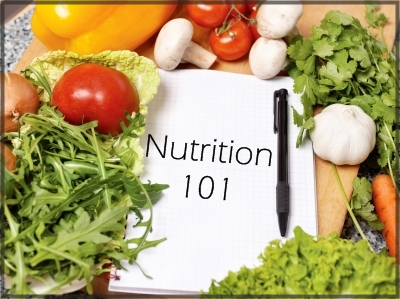Throughout this Nutrition 101 series we’ve counted calories, compared carbs, and highlighted the pros of lean protein, healthy fats and a diet rich in vitamins and minerals. Here are some of the top tips from this series to remember.
Top 5 tips to help you eat more nutritiously:
 1. When it comes to carbohydrates–the more natural & whole, the better.
1. When it comes to carbohydrates–the more natural & whole, the better.
Go for complex carbs like 100% whole grain breads and pasta, brown rice, starchy vegetables (just leave the nutrient-rich skins on those potatoes), legumes, nuts, seeds, low-fat dairy and plenty of fruits and vegetables. Limit simple sugars from refined grains, processed snack foods, sweets, and sugar-sweetened beverages.
 2. Keep protein lean.
2. Keep protein lean.
It’s perfectly okay to indulge in breakfast sausage and cheeseburgers on occasion. But on an everyday basis, there are plenty of great lean proteins to choose from! Some good meat-free options include beans, peas, quinoa, lentils, tofu, low-fat yogurt and 1% milk. Fish is another great source of protein that can also be rich in healthy Omega-3s. And as far as meats go, cuts that have round, chuck, or loin in the name are usually leanest, along with chicken and turkey breast.
 3. Make healthy fats your friend.
3. Make healthy fats your friend.
Add avocados, nuts, seeds and nut butters and fatty fish like salmon into your weekly menu. Cook with oils like olive or grape seed instead of butter or lard. Make salad dressings with flaxseed oil for a healthy dose of Omega-3s. You can even substitute avocado for butter when baking!
 4. Incorporate colorful foods into every meal.
4. Incorporate colorful foods into every meal.
From dark greens to red berries, orange bell peppers and white onions, the colors in fruits, vegetables and even proteins are associated with important vitamins and minerals. Eating a rainbow of colorful foods, especially fruits and vegetables, is an great way to get a variety of micronutrients in your diet.
 5. Make the most of your calories.
5. Make the most of your calories.
Eat a balance of carbohydrates, proteins and fats at each meal and choose foods rich in fiber, vitamins and minerals. A good way to do this is to fill your plate with 3-4 food groups at each meal. Eat a combination of protein foods, whole grains, dairy, fruits and vegetables, and incorporate the groups you miss into other meals and snacks throughout the day.
Nutrition can seem complicated, but it doesn’t have to be. Remember, healthful eating does not mean eating perfectly. It’s about making more nutritious choices most of the time, nourishing our bodies with real food and enjoying the occasional treat along the way!
Healthy Nutrition: Guidelines to Get You Going
Here are some other tips to help you develop a healthy eating plan. If you keep these general nutrition rules in mind, you’ll be on the right track toward healthy eating for life:
- Pay attention to portion control; quantities depend on whether you’re trying to lose or maintain weight. In most restaurants, an appetizer serving is often closer to an appropriate serving size than an entrée.
- Always drink plenty of water.
- Vary your food choices to make sure you get a wide variety of vitamins and other nutrients and to avoid boredom.
- Know the recommended daily calorie intake for your age, weight, height, activity level, and gender.
- Don’t deprive yourself of foods you love; just enjoy them in moderation.
Start by thinking about the basics of diet and nutrition again, and part of your everyday life. It won’t be a diet, it won’t be a fad, and it definitely won’t be temporary. It will be your new healthy lifestyle, and when you think, “What’s for dinner?” the answer will naturally be a healthy choice.
I hope you enjoyed the series and learned some nutrition basics in the process.
You may also like:
- Six Weeks to a Healthier Diet
- Smart Start Menu Series
- Tips for putting together healthy menus
- Walk Talk Series
Just click on the link to take you to the topics in the series
- Nutrition 101 – Introduction to basic Nutrition
- Nutrition 101 – Calories
- Nutrition 101 – Carbohydrates
- Nutrition 101 – Proteins
- Nutrition 101 – Fats
- Nutrition 101 – Micronutrients ( Vitamins and Minerals)
- Nutrition 101 – Fiber
- Nutrition 101 – Water
- Nutrition 101- Recap – 5 Tips to Eat More Nutritiously
SOURCE: Elle Penner, M.P.H., R.D., Dietary Reference Intakes for Energy, Carbohydrate. Fiber, Fat, Fatty Acids, Cholesterol, Protein, and Amino Acids,

